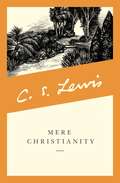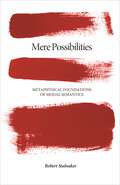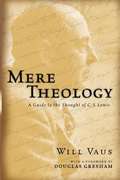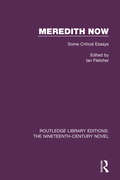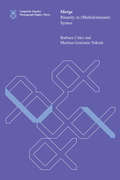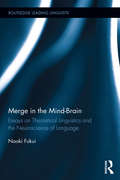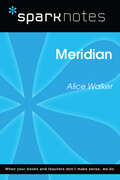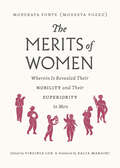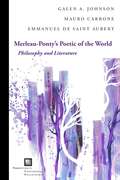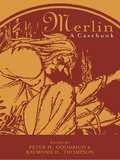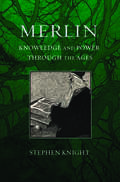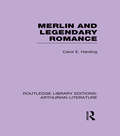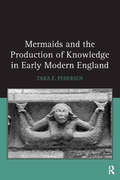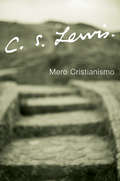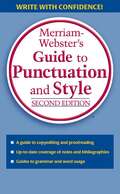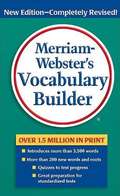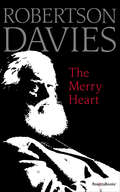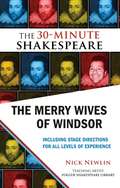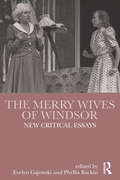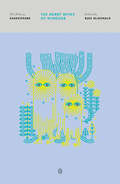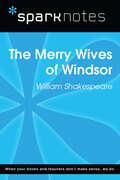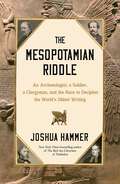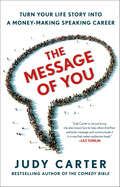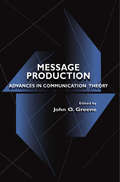- Table View
- List View
Mere Christianity
by C. S. LewisA forceful and accessible discussion of Christian belief that has become one of the most popular introductions to Christianity and one of the most popular of Lewis's books. Uncovers common ground upon which all Christians can stand together.
Mere Possibilities: Metaphysical Foundations of Modal Semantics (Carl G. Hempel Lecture Series #2)
by Robert StalnakerIt seems reasonable to believe that there might have existed things other than those that in fact exist, or have existed. But how should we understand such claims? Standard semantic theories exploit the Leibnizian metaphor of a set of all possible worlds: a proposition might or must be true if it is true in some or all possible worlds. The actualist, who believes that nothing exists except what actually exists, prefers to talk of possible states of the world, or of ways that a world might be. But even the actualist still faces the problem of explaining what we are talking about when we talk about the domains of other possible worlds. In Mere Possibilities, Robert Stalnaker develops a framework for clarifying this problem, and explores a number of actualist strategies for solving it. Some philosophers have hypothesized a realm of individual essences that stand as proxies for all merely possible beings. Others have argued that we are committed to the necessary existence of everything that does or might exist. In contrast, Mere Possibilities shows how we can make sense of ordinary beliefs about what might and must exist without making counterintuitive metaphysical commitments. The book also sheds new light on the nature of metaphysical theorizing by exploring the interaction of semantic and metaphysical issues, the connections between different metaphysical issues, and the nature of ontological commitment.
Mere Theology: A Guide to the Thought of C. S. Lewis
by Will VausWhat did C. S. Lewis believe about God, Jesus Christ, the Holy Spirit, heaven, hell, creation, the Fall, the forgiveness of sins, marriage and divorce, war and peace, the church and sacraments, masculinity and femininity? Lewis was not a professional theologian, but anyone who has read his writings--whether fiction or nonfiction, essays or correspondence--knows that profoundly Christian convictions permeate them all. The more one reads, the more it becomes clear that Lewis could write with charity and simplicity while preserving theological accuracy because he was well informed and thoroughly grounded in the Christian faith. Will Vaus has masterfully brought together Lewis's thought from throughout his voluminous writings to provide us a full-orbed look into his beliefs on twenty-five Christian themes. This book gives us not only a comprehensive view of Lewis's theological convictions but also guidance and encouragement for our own spiritual journeys toward the God whom Lewis found so real, personal and present. Introduction by Douglas Gresham.
Meredith Now: Some Critical Essays (Routledge Library Editions: The Nineteenth-Century Novel #13)
by Ian FletcherThere is no English novelist whose reputation has fluctuated so violently as that of George Meredith. First published in 1971, this volume of essays reassesses the works of George Meredith. Despite his unevenness, the essays demonstrate that Meredith was an important experimental writer and as one of the masters of the English novel. This book will be of interest to those studying 19th Century literature.
Merge: Binarity in (Multidominant) Syntax (Linguistic Inquiry Monographs #83)
by Barbara Citko Martina Gracanin-YuksekAn argument that Merge is binary but its binarity refers to syntactic positions rather than objects.In this book, Barbara Citko and Martina Gračanin-Yüksek examine the constraints on Merge--the basic structure-building operation in minimalist syntax--from a multidominant perspective. They maintain that Merge is binary, but argue that the binarity of Merge refers to syntactic positions Merge relates: what has typically been formulated as a constraint that prevents Merge from combining more than two syntactic objects is a constraint on Merge's relating more than two syntactic positions.
The Merge Hypothesis: A Theory of Aspects of Syntax
by Norbert HornsteinThe Merge Hypothesis is the central empirical theoretical contribution of the Minimalist Program (MP) to syntactic theory. This book offers an accessible overview of the MP, debunking common sixty years of Generative research, culminating in GB theory. He introduces The Fundamental Principle of Grammar, which advocates including labels as part of the Merge Operation and centring the notion of the constituent as the key domain of syntactic commerce. The early chapters identify the goals of the MP, how they arose from earlier descriptive and explanatory successes of the mentalist tradition within Generative Grammar, and how to develop them in future work to expand its descriptive and explanatory range. It is essential reading for anyone interested in contemporary syntactic theory.
Merge in the Mind-Brain: Essays on Theoretical Linguistics and the Neuroscience of Language (Routledge Leading Linguists)
by Naoki FukuiThis collection of nine papers brings together Naoki Fukui’s pioneering body of work on Merge, the basic operation of human language syntax, from the two distinct but related perspectives of theoretical syntax and neurosciences. Part I presents an overview of the development of the theory of Merge and its current formulations in linguistic theory, highlighting the author’s previously published papers in theoretical syntax, while Part II focuses on experimental research on Merge in the brain science of language, demonstrating how new techniques and the results they produce can inform the study of syntactic structures in the brain in the future. By combining insights from theoretical linguistics and neurosciences, this book presents an innovative unified account of the study of Merge and paves new directions for future research for graduate students and scholars in theoretical linguistics, neuroscience, syntax, and cognitive science.
Meridian (SparkNotes Literature Guide Series)
by SparkNotesMeridian (SparkNotes Literature Guide) by Alice Walker Making the reading experience fun!Created by Harvard students for students everywhere, SparkNotes is a new breed of study guide: smarter, better, faster. Geared to what today's students need to know, SparkNotes provide:Chapter-by-chapter analysisExplanations of key themes, motifs, and symbolsA review quiz and essay topicsLively and accessible, these guides are perfect for late-night studying and writing papers.
The Merits of Women: Wherein Is Revealed Their Nobility and Their Superiority to Men
by Moderata Fonte“Among the great classics of early feminist thought . . . challenging, witty . . . a sometimes startlingly original discussion of women’s status.” —Literary HubYou would as well look for blood in a corpse as for the least shred of decency in a man . . .Without help from their wives, men are just like unlit lamps . . .Just think of them as an unreliable clock that tells you it’s ten o’clock when it’s in fact barely two . . .These are but a small selection of the quips bandied about at this lively gathering of women. Yet this dialogue unfolds not among ironically misandrist millennials venting at their local dive bar, but rather among sixteenth-century women—variously married, widowed, single, and betrothed—attending a respectable Venice garden party. Written in the early 1590s by Moderata Fonte, pseudonym of the Renaissance poet and writer Modesta Pozzo, this literary dialogue interrogates men and men’s treatment of women, and explores by contrast the virtues of singledom and female friendship.A new introduction by translator Virginia Cox and foreword by Dacia Maraini situate The Merits of Women in its historical context, written as it was on the cusp of Shakespeare’s heyday, and straddling the centuries between the feminist works of Christine de Pizan and Mary Wollstonecraft. Elegantly presented for a general audience, this is a must-read for baby feminists and “nasty women” alike, not to mention the perfect subtle gift for any mansplaining friend who needs a refresher on the merits of women . . . and their superiority to men.
Merleau-Ponty's Poetic of the World: Philosophy and Literature (Perspectives in Continental Philosophy)
by Galen A. Johnson Mauro Carbone Emmanuel de Saint AubertMerleau-Ponty has long been known as one of the most important philosophers of aesthetics, yet most discussions of his aesthetics focus on visual art. This book corrects that balance by turning to Merleau-Ponty's extensive engagement with literature.From Proust, Merleau-Ponty developed his conception of “sensible ideas,” from Claudel, his conjoining of birth and knowledge as “co-naissance,” from Valéry came “implex” or the “animal of words” and the “chiasma of two destinies.” Literature also provokes the questions of expression, metaphor, and truth and the meaning of a Merleau-Pontian poetics.The poetic of Merleau-Ponty is, the book argues, a poetic of the flesh, a poetic of mystery, and a poetic of the visible in its relation to the invisible. Ultimately, theoretical figures or “figuratives” that appear at the threshold between philosophy and literature enable the possibility of a new ontology. What is at stake is the very meaning of philosophy itself and its mode of expression.
Merlin: A Casebook (Arthurian Characters and Themes #7)
by Peter H. Goodrich Raymond H. ThompsonFirst Published in 2003. Routledge is an imprint of Taylor & Francis, an informa company.
Merlin: Knowledge and Power through the Ages
by Stephen KnightMerlin, the wizard of Arthurian legend, has been a source of enduring fascination for centuries. In this authoritative, entertaining, and generously illustrated book, Stephen Knight traces the myth of Merlin back to its earliest roots in the early Welsh figure of Myrddin. He then follows Merlin as he is imagined and reimagined through centuries of literature and art, beginning with Geoffrey of Monmouth, whose immensely popular History of the Kings of Britain (1138) transmitted the story of Merlin to Europe at large. He covers French and German as well as Anglophone elements of the myth and brings the story up to the present with discussions of a globalized Merlin who finds his way into popular literature, film, television, and New Age philosophy. Knight argues that Merlin in all his guises represents a conflict basic to Western societies-the clash between knowledge and power. While the Merlin story varies over time, the underlying structural tension remains the same whether it takes the form of bard versus lord, magician versus monarch, scientist versus capitalist, or academic versus politician. As Knight sees it, Merlin embodies the contentious duality inherent to organized societies. In tracing the applied meanings of knowledge in a range of social contexts, Knight reveals the four main stages of the Merlin myth: Wisdom (early Celtic British), Advice (medieval European), Cleverness (early modern English), and Education (worldwide since the nineteenth century). If a wizard can be captured within the pages of a book, Knight has accomplished the feat.
Merlin and Legendary Romance (Routledge Library Editions: Arthurian Literature)
by Carol HardingAn indepth work on the origins of the Merlin of Arthurian legend, this book examines early texts, thirteenth century romances focusing particularly on Merlin as a character, rather than those where Merlin is a background cast member. The outline here starts with looking at the genre and the place of fantasy, moving on to consider the attitudes towards magic and magic-users in medieval times. Main works considered are Geoffrey of Monmouth’s Historia Regum Britanniae and Vita Merlini; the Vulgate cycle, Suite du Merlin; and finally Malory’s work. The author asserts that each portrays a different approach to Merlin but all are tied to history and to the Christian religion.
Mermaids and the Production of Knowledge in Early Modern England
by Tara E. PedersenWe no longer ascribe the term ’mermaid’ to those we deem sexually or economically threatening; we do not ubiquitously use the mermaid’s image in political propaganda or feature her within our houses of worship; perhaps most notably, we do not entertain the possibility of the mermaid’s existence. This, author Tara Pedersen argues, makes it difficult for contemporary scholars to consider the mermaid as a figure who wields much social significance. During the early modern period, however, this was not the case, and Pedersen illustrates the complicated category distinctions that the mermaid inhabits and challenges in 16th-and 17th-century England. Addressing epistemological questions about embodiment and perception, this study furthers research about early modern theatrical culture by focusing on under-theorized and seldom acknowledged representations of mermaids in English locations and texts. While individuals in early modern England were under pressure to conform to seemingly monolithic ideals about the natural order, there were also significant challenges to this order. Pedersen uses the figure of the mermaid to rethink some of these challenges, for the mermaid often appears in surprising places; she is situated at the nexus of historically specific debates about gender, sexuality, religion, the marketplace, the new science, and the culture of curiosity and travel. Although these topics of inquiry are not new, Pedersen argues that the mermaid provides a new lens through which to look at these subjects and also helps scholars think about the present moment, methodologies of reading, and many category distinctions that are important to contemporary scholarly debates.
Mero Cristianismo
by C. S. LewisEsta obra poderosa y práctica es una de las más populares y queridas introducciones a la fe cristiana jamás escritaMero Cristianismo reúne las legendarias charlas radiofónicas de C. S. Lewis que se transmitieron durante tiempos de guerra, charlas en las cuales él se proponía "explicar y defender las creencias que han sido común a casi todos los cristianos de todos los tiempos." Rechazando los límites que dividen las distintas denominaciones del cristianismo, C. S. Lewis ofrece una inigualable oportunidad al creyente y al no creyente para escuchar un argumento fuerte y racional para la fe cristiana.Esta es una colección de la genialidad de Lewis que aún se mantiene viva para el lector moderno y que a la vez confirma su reputación como el escritor y pensador más importante de nuestros tiempos. Mero Cristianismo es su libro más popular y ha vendido millones de ejemplares a través del mundo.
Merriam-Webster's Guide to Punctuation and Style
by Merriam-WebsterWrite with confidence with this informative, quick-reference guide to punctuation and style! <p> <p>• Answers questions about punctuation, capitalization, italicization, abbreviation, quotation, and documentation of sources <p>• Provides instructions for preparing notes and bibliographies <p>• Includes a guide to copyediting and proofreading <p>• Firmly based on real-life source material, reflecting both the consensus and the variety in American published writing
Merriam-Webster's Vocabulary Builder
by Mary Wood CornogThe ideal book for people who want to increase their word power. Thorough coverage of 1,200 words and 240 roots while introducing 2,300 words. The Vocabulary Builder is organized by Greek and Latin roots for effective study with nearly 250 new words and roots. Includes quizzes after each root discussion to test progress. A great study aid for students preparing to take standardized tests.
The Merry Heart: Reflections on Reading, Writing, and the World of Books
by Robertson Davies&“A splendid gallimaufry of the eminent Canadian&’s talks and essays, mostly about literature and the creative life . . . a thought-filled and amusing book.&”—The Washington Post For devotees of Davies and all lovers of literature and language, here is the &“urbanity, wit, and high seriousness mixed by a master chef,&” vintage delights from an exquisite literary menu (Cleveland Plain Dealer). Robertson Davies&’s rich and varied collection of writings on the world of books and the miracle of language captures his inimitable voice and sustains his presence among us. Coming almost entirely from Davies&’s own files of unpublished material, these twenty-four essays and lectures range over themes from &“The Novelist and Magic&” to &“Literature and Technology,&” from &“Painting, Fiction, and Faking,&” to &“Can a Doctor Be a Humanist?&” and &“Creativity in Old Age.&” Davies himself says merely: &“Lucky writers . . . like wine, die rich in fruitiness and delicious aftertaste, so that their works survive them.&” &“Splendid—wise, witty, wide-ranging.&”—The New York Times Book Review &“Some of Davies&’s ideas are iconoclastic, and will delight those who share them while stimulating those who do not. All his judgments are interesting, steeped in humanism, and most elegantly put.&”—The Atlantic Monthly &“The inimitable novelist gives an exuberant posthumous performance in this eclectic collection of (mostly) previously unpublished addresses, talks, and incidental pieces . . . Davies diffuses his opinions entertainingly, if occasionally superficially, but never loses his audience.&”—Kirkus Reviews
The Merry Wives of Windsor: The 30-Minute Shakespeare
by Nick NewlinPlanning a school or amateur Shakespeare production? The best way to experience the plays is to perform them, but getting started can be a challenge: The complete plays are too long and complex, while scene selections or simplified language are too limited."The 30-Minute Shakespeare" is a new series of abridgements that tell the "story" of each play from start to finish while keeping the beauty of Shakespeare's language intact. Specific stage directions and character suggestions give even inexperienced actors the tools to perform Shakespeare with confidence, understanding, and fun!This cutting of THE MERRY WIVES OF WINDSOR begins with one of Shakespeare's favorite fat knights, Sir John Falstaff, announcing his intention to woo both Mistress Ford and Mistress Page simultaneously, to the delight of his cohorts Bardolph, Pistol, and Nym, who then decide to double-cross Falstaff. The characters' movements on stage are clearly denoted so that even inexperienced actors can give the scenes life: Robin is nearsighted, Bardolph is a drunk who tries to juggle, and Pistol and Nym are constantly jostling for position. Other key moments include the hilarious wooing of Mistress Ford by Falstaff and the hysterical concealment of Falstaff in the laundry basket. The cutting ends in the woods with Falstaff dressed as a stag, being tormented by fairies for his comeuppance.The edition also includes an essay by editor Nick Newlin on how to produce a Shakespeare play with novice actors, and notes about the original production of this abridgement at the Folger Shakespeare Library's annual Student Shakespeare Festival.
The Merry Wives of Windsor: New Critical Essays (Shakespeare Criticism)
by Phyllis Rackin Evelyn GajowskiThe Merry Wives of Windsor has recently experienced a resurgence of critical interest. At times considered one of Shakespeare’s weaker plays, it is often dismissed or marginalized; however, developments in feminist, ecocritical and new historicist criticism have opened up new perspectives and this collection of 18 essays by top Shakespeare scholars sheds fresh light on the play. The detailed introduction by Phyllis Rackin and Evelyn Gajowski provides a historical survey of the play and ties into an evolving critical and cultural context. The book’s sections look in turn at female community/female agency; theatrical alternatives; social and theatrical contexts; desire/sexuality; nature and performance to provide a contemporary critical analysis of the play.
The Merry Wives of Windsor (The Pelican Shakespeare)
by William Shakespeare Russ Mcdonald Stephen Orgel A. R. BraunmullerThe acclaimed Pelican Shakespeare series edited by A. R. Braunmuller and Stephen Orgel The legendary Pelican Shakespeare series features authoritative and meticulously researched texts paired with scholarship by renowned Shakespeareans. Each book includes an essay on the theatrical world of Shakespeare’s time, an introduction to the individual play, and a detailed note on the text used. Updated by general editors Stephen Orgel and A. R. Braunmuller, these easy-to-read editions incorporate over thirty years of Shakespeare scholarship undertaken since the original series, edited by Alfred Harbage, appeared between 1956 and 1967. With definitive texts and illuminating essays, the Pelican Shakespeare will remain a valued resource for students, teachers, and theater professionals for many years to come. For more than seventy years, Penguin has been the leading publisher of classic literature in the English-speaking world. With more than 1,700 titles, Penguin Classics represents a global bookshelf of the best works throughout history and across genres and disciplines. Readers trust the series to provide authoritative texts enhanced by introductions and notes by distinguished scholars and contemporary authors, as well as up-to-date translations by award-winning translators.
The Merry Wives of Windsor (SparkNotes Literature Guide Series)
by SparkNotesThe Merry Wives of Windsor (SparkNotes Literature Guide) by William Shakespeare Making the reading experience fun! Created by Harvard students for students everywhere, SparkNotes is a new breed of study guide: smarter, better, faster. Geared to what today's students need to know, SparkNotes provides: *Chapter-by-chapter analysis *Explanations of key themes, motifs, and symbols *A review quiz and essay topicsLively and accessible, these guides are perfect for late-night studying and writing papers
The Mesopotamian Riddle: An Archaeologist, a Soldier, a Clergyman, and the Race to Decipher the World's Oldest Writing
by Joshua HammerA rollicking adventure starring three free-spirited Victorians on a twenty-year quest to decipher cuneiform, the oldest writing in the world—from the New York Times bestselling author of The Bad-Ass Librarians of Timbuktu.It was one of history&’s great vanishing acts. Around 3,400 BCE—as humans were gathering in complex urban settlements—a scribe in the mud-walled city-state of Uruk picked up a reed stylus to press tiny symbols into clay. For three millennia, wedge shape cuneiform script would record the military conquests, scientific discoveries, and epic literature of the great Mesopotamian kingdoms of Sumer, Assyria, and Babylon and of Persia&’s mighty Achaemenid Empire, along with precious minutiae about everyday life in the cradle of civilization. And then…the meaning of the characters was lost. London, 1857. In an era obsessed with human progress, mysterious palaces emerging from the desert sands had captured the Victorian public&’s imagination. Yet Europe&’s best philologists struggled to decipher the bizarre inscriptions excavators were digging up. Enter a swashbuckling archaeologist, a suave British military officer turned diplomat, and a cloistered Irish rector, all vying for glory in a race to decipher this script that would enable them to peek farther back into human history than ever before. From the ruins of Persepolis to lawless outposts of the crumbling Ottoman Empire, The Mesopotamian Riddle whisks you on a wild adventure through the golden age of archaeology in an epic quest to understand our past.
The Message of You: Turn Your Life Story into a Money-Making Speaking Career
by Judy CarterA step-by-step handbook that teaches readers to find the extraordinary stories tucked deep within them to make a difference in the lives of others—and to get paid—as a motivational speakerTHE MESSAGE OF YOU begins with a simple belief - that your greatest speech already exists and that it has already been delivered in front of a live audience masterfully and powerfully by you. Best-selling author and international comic, Judy Carter sets out to prove that THE MESSAGE OF YOU is in the advice you give to your friends; in the lessons you teach your children; in the stories you tell your family. It's expressed through the volunteer work you do, the way you run your business, the way you turned your messes into successes. THE MESSAGE OF YOU is a distillation of all of your experiences, both personal and professional, that form the narrative meaning of your life. A meaning that you can develop into a well-written, funny speech to inspire audiences, enhance your current profession, and launch a successful money making career as a professional speaker. In Part One of the book, Judy leads you through a series of in-depth exercises meant to mine your personal and professional experiences for stories that establish your qualifications, your problem/solutions, your action steps and your methodology. In Part Two, Judy has created a six-step structure for writing an entertaining and informative speech, guiding you through each step in detail. But the real bonus of THE MESSAGE OF YOU is that Judy is a comic. Her "Comedy Pass" chapter takes you through simple but effective comedy writing techniques that will transform even a flat PowerPoint snoozer into a knee-slapping showstopper of a keynote. Once your speech is well-written and funny, Judy takes you through Part Three, teaching you how to take your message to the masses with inexpensive but essential marketing tips. The Message of You offers an accessible approach, big picture guidance, and nitty-gritty nuts and bolts of sound advice. Judy has been a comedy and speaking coach for over twenty years. She's a firm believer that how you present your ideas is just as important as the ideas themselves. She knows that humor and strong content are the missing ingredients in most speeches and her book, THE MESSAGE OF YOU helps you discover both your message and your comedic voice by taking you through the same process she uses to coach her private clients.
Message Production: Advances in Communication Theory (Routledge Communication Series)
by John O. GreeneThe last two decades have seen the development of a number of models that have proven particularly important in advancing understanding of message-production processes. Now it appears that a "second generation" of theories is emerging, one that reflects considerable conceptual advances over earlier models. Message Production: Advances in Communication Theory focuses on these new developments in theoretical approaches to verbal and nonverbal message production. The chapters reflect a number of characteristics and trends resident in these theories including: * the nature and source of interaction goals; * the impact of physiological factors on message behavior; * the prominence accorded conceptions of goals and planning; * attempts to apply models of intra-individual processes in illuminating inter-individual phenomena; * treatments which involve hybrid intentional/design-stance approaches; and * efforts to incorporate physiological constructs and to meld them with psychological and social terms. The processes underlying the production of verbal and nonverbal behaviors are exceedingly complex, so much so that they resist the development of unified explanatory schemes. The alternative is the mosaic of emerging theories such as are represented in this book -- each approach according prominence to certain message-production phenomena while obscuring others, and providing a window on some portion of the processes that give rise to those phenomena while remaining mute about other processes. The amalgam of these disparate treatments, then, becomes the most intellectually compelling characterization of message-production processes.
